POND ISLAND LIGHT, ME. This 1855-built, active 20' round cylindrical brick tower with lantern and gallery has a solar-powered 250 mm lens. The tower is painted white, the lantern and gallery are painted black. Its fog horn sounds 2 blasts every 30 seconds. The keeper’s house an all other light station buildings were demolished in 1963. The 10-acre treeless island it is located on is an important bird sanctuary (terns) and is closed to the public April through August. Owned by the U.S. Fish and Wildlife Service, the site manager is the Maine Audubon Society (Pond Island National Wildlife Refuge).
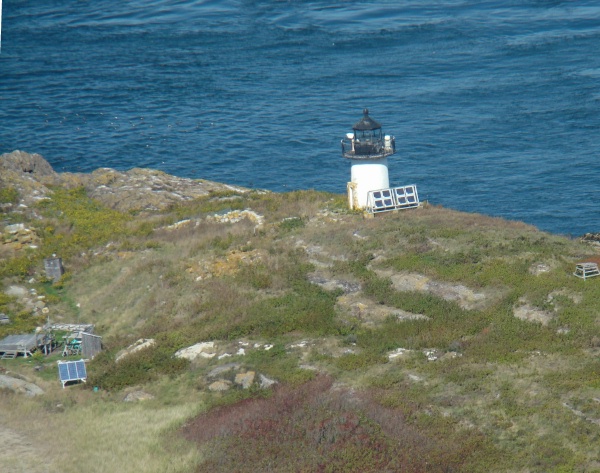
LITTLE MARK ISLAND MONUMENT, ME. One of about a dozen granite towers built as daymarkers on the New England coast during the 19th century. Built in 1827, this 50' unpainted square pyramidal granite monument with an active modern light mounted at the top was originally built as a daymark and was not intended to be a lighthouse. A black vertical stripe is painted on each side of the tower, which is otherwise unpainted white granite. The tower has a room at the base, originally meant as a shelter for shipwrecked sailors and is now used for storage batteries for the light. The upper part of the tower is solid, so the Coast Guard has mounted a ladder on the side to provide access to the lens at the top. It is not known when it became a lighted aid to navigation. The light displays a white flash every 4 seconds and has a range of 5 miles. Located on Little Mark Island about 1 mile southwest of the tip of Bailey Island and 3 miles north of Halfway Rock. Owner/site manager: U.S. Coast Guard.
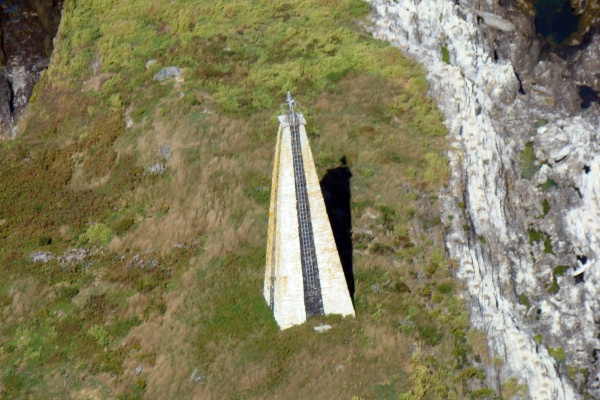
HALFWAY ROCK LIGHT, ME. Located in the middle of Casco Bay, roughly midway between Cape Elizabeth and Cape Small. This lighthouse proved indispensable to mariners in a heavy fog, even with Sequin Island Light a short distance away.
In 1869, after years of demands, huge granite blocks were brought from other Maine islands by boat and unloaded on Halfway Rock, where the surface of the rock had been cut to the proper level. The 76' cone-shaped white granite lighthouse with a black cast iron lantern was finally completed and its revolving 3rd-Order Fresnel lens, showing a white light punctuated by a red flash, was lit for the first time in August of 1871. A pyramidal, skeleton bell tower, standing 48' high and constructed of 10" square yellow pine timbers, was bolted to the ledge 80' from the lighthouse in 1887. A striking mechanism delivered regular blows to a 1,000 pound bell suspended in the tower. During the bell tower’s first winter, a sea with a depth of 8' swept over the ledge beneath the tower. The fog bell was replaced in 1905 by a diesel-powered Daboll fog trumpet.
The tower originally doubled as a dwelling for the keepers. A kitchen was located on the first floor, the principal keeper lived on the second floor, the two assistants on a third level, and a watchroom, outfitted with a small stove and a desk, was located directly beneath the lantern room. In 1884, a wooden boathouse measuring 18' x 24' with 2 bedrooms in its loft, was constructed in the lee (on or toward the side of a ship, natural feature, or object that is away from the wind) of the lighthouse. The boathouse was securely bolted to both the ledge and the tower, and a sloping wooden ramp connected the structure to the water.
There were three keepers employed at Halfway Rock–two always on duty and the third on shore leave. Due to the tight living conditions, no families or spouses were allowed at the station. Automated in 1975, modern, solar-powered optic replaced the Fresnel lens which was placed on display at the U.S. Coast Guard Academy in New London, CT.
The station was leased to the American Lighthouse Foundation in 2000. Maine Historic Preservation Commission declared Halfway Rock Lighthouse one of the state’s “Ten Most Endangered Historic Properties” in 2004. It is hoped ALF will be able to save this maritime landmark.
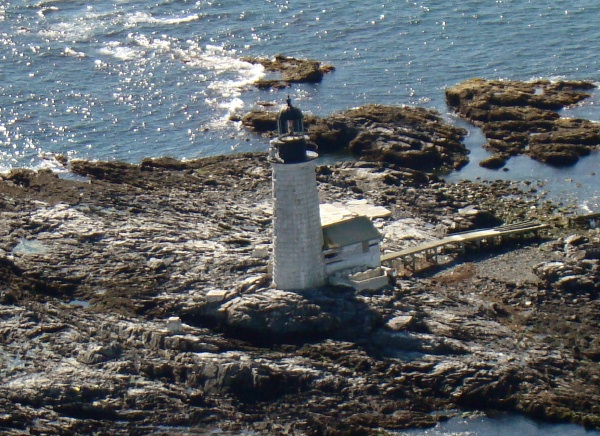
Tuesday found us traveling by car to photograph two lights, and search for two more. The first was:
WHITLOCK’S MILL LIGHT, ME. Built in 1910, this active 25' round, cylindrical brick tower with lantern and gallery uses a 1969-installed 250 mm lens for its optic. The lighthouse is painted white, the lantern is painted black. The original 4th-Order Fresnel lens is on display at the Maine Lighthouse Museum in Rockland, ME. The original 2-story stucco keeper’s house, and square pyramidal wood bell tower (bell removed), and brick oil house survive on site. The interior of the tower is lined with ceramic tile, an unusual feature. The tower was transferred to the St. Croix Historical Society under the Maine Lights program in 1998. The keeper’s house has been a private residence since the 1970s; it was sold in late 2004 or early 2005 and the new owners have restored the building. Located on the south bank of the St. Croix River about 3 miles east of Calais. Site and tower are closed, but the light can be viewed from a roadside park on US 1.
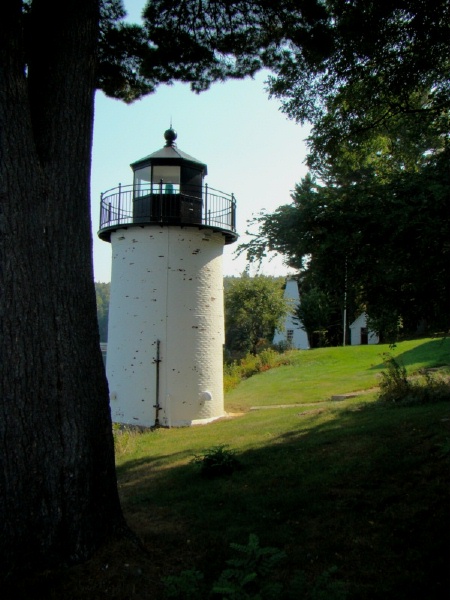
ST. CROIX RIVER LIGHT REMAINS, ME. The historic 1857 lighthouse (rebuilt in 1901) was destroyed by fire in 1976. The active light has a focal plane 101' above sea level showing a white flash every 2˝ seconds; it is on a platform at the top of a steel skeletal tower. The 1-story painted white boathouse shown here is all that survives of the station. Designated a national park in 1984, the island was a French settlement in 1604-‘05 and its 400th anniversary was celebrated in 2004. As part of the improvements to the park, the National Park Service restored the landing and boathouse, but the oil house was demolished. Located on St. Croix (Dochet) Island in the St. Croix River about 3 miles north of Robbinston. This picture was taken from the St. Croix Island International Historic Site Visitor Center off US 1 about a mile from the island. Owned by the US National Park Service, the site manager is the St. Croix Island International Historic Site.
St. Croix River Light was built in 1857 on St. Croix Island to mark the entrance to the
St. Croix River on the U.S./Canadian border. It is listed as the first lighthouse of the First Lighthouse District. The lighthouse was an octagonal wooden tower on top of the keeper’s house. The lantern held a 5th-Order Fresnel lens. A fog bell tower with striking machinery was also built. The lighthouse was rebuilt in 1901 in a style very similar to the original structure. The station was considered highly desirable by keepers and their families, with a comfortable house and beautiful surroundings.
Automated in 1957, the keepers were removed leaving the station abandoned. In 1976 a group of youngsters landed on the island and started a fire on a windy day. Every building on the island except the boathouse were soon reduced to ashes.
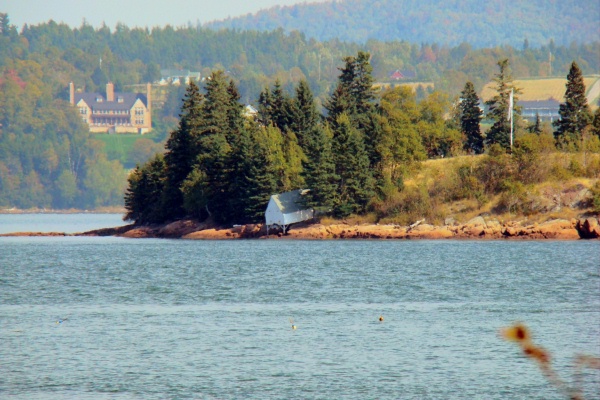
We spent the better part of the remainder of the day trying to get a view of Narraguagus (Pond Island) and Little River lights. Both lights are on the ocean side of the islands they are built on and nobody was working at the harbors that we might convince to take us around the island on their boat. We went back to the campsite and decided to try for a flight on Thursday. We were going to try for a helicopter flight, but I phoned Scenic Flights of Acadia and asked if their pilot would take us to Narraguagus and Little River. Rolf called back to say the plane was fueled and the flight plan okayed, but a storm was coming in and we might only be able to get one of the two we wanted to photograph. One is always better than none where I come from, so we hurried to the airfield and took off for:

